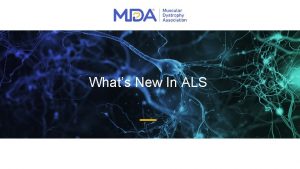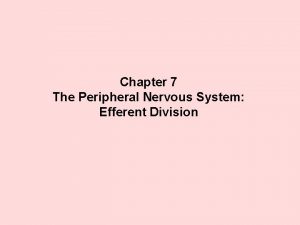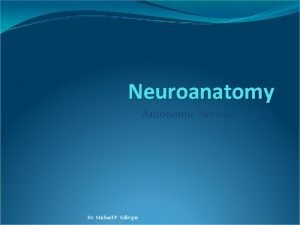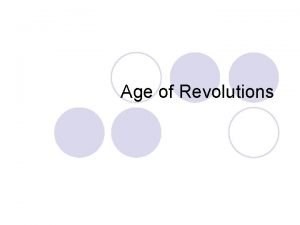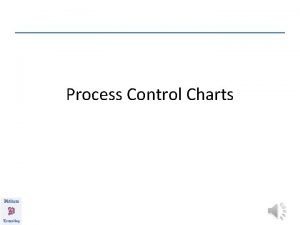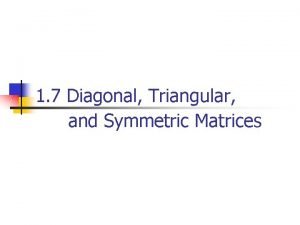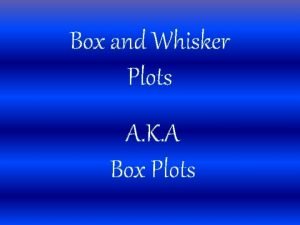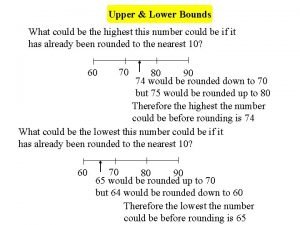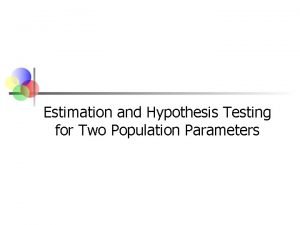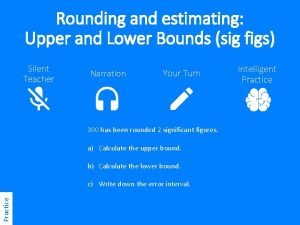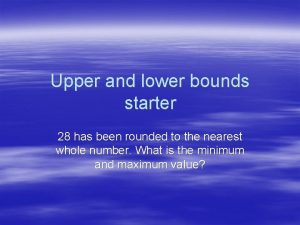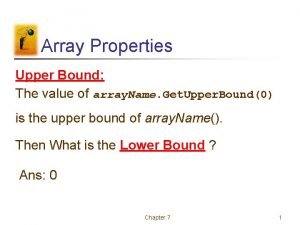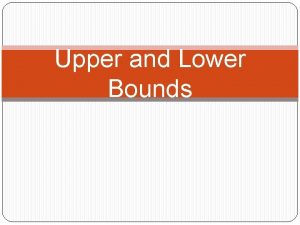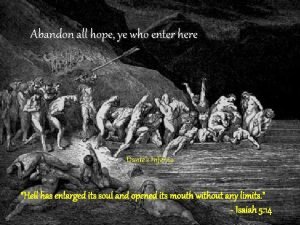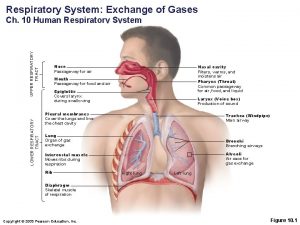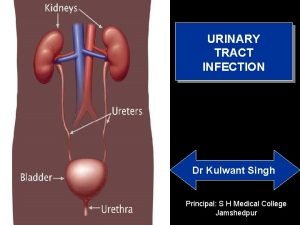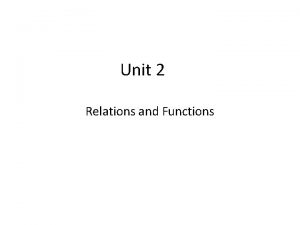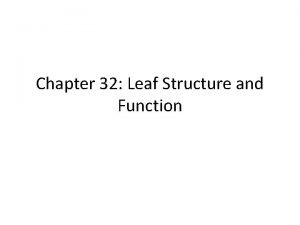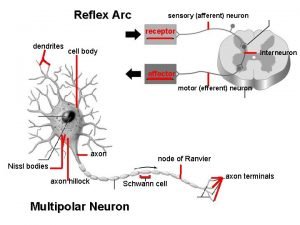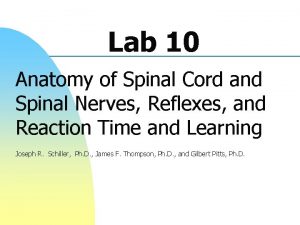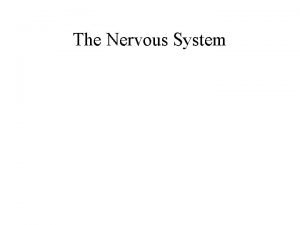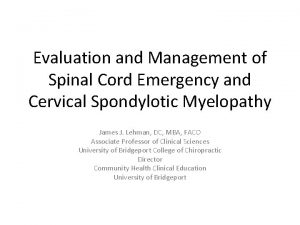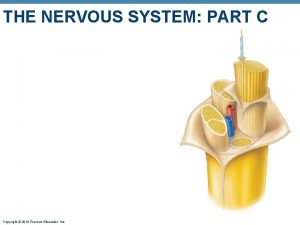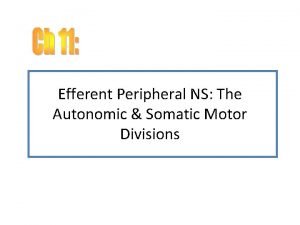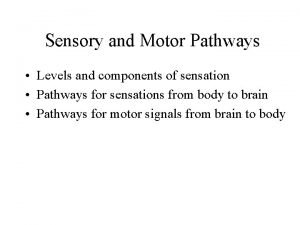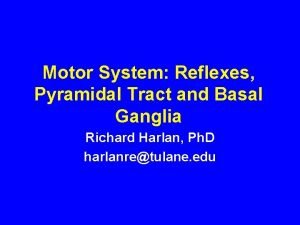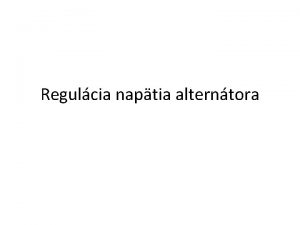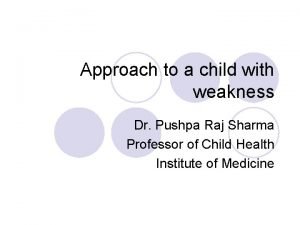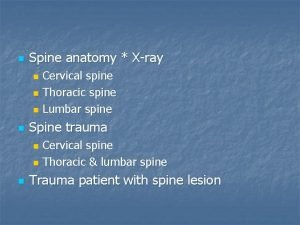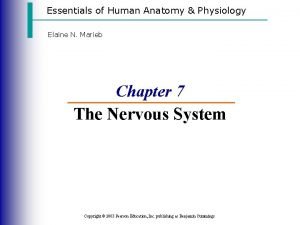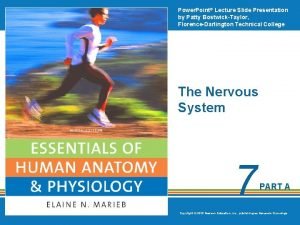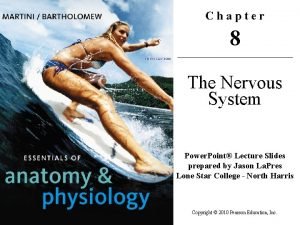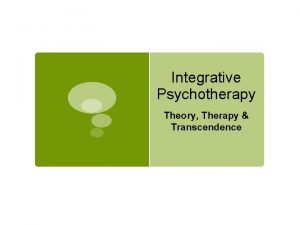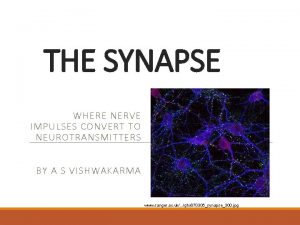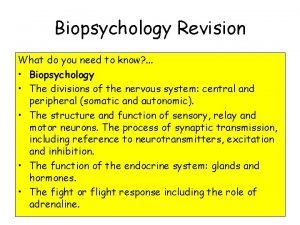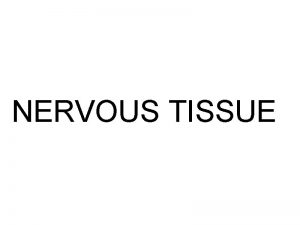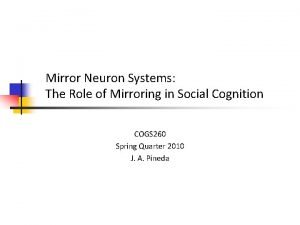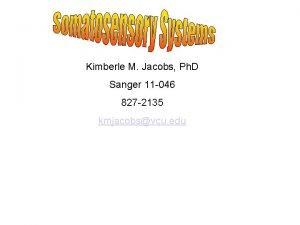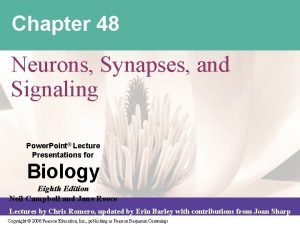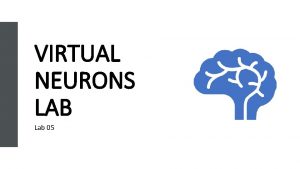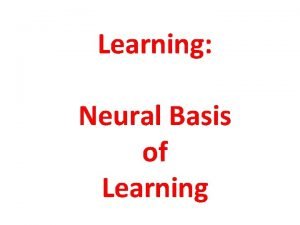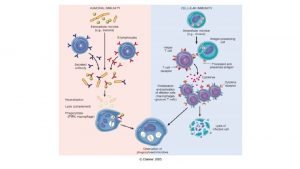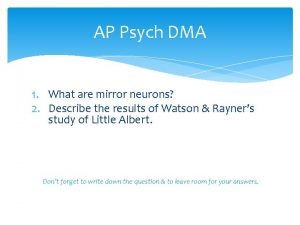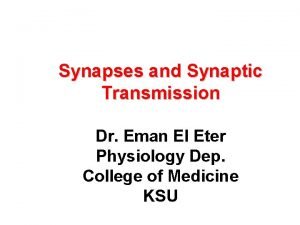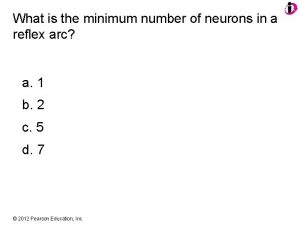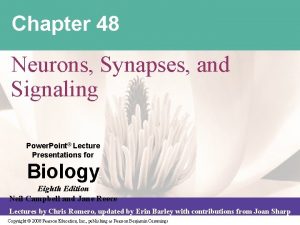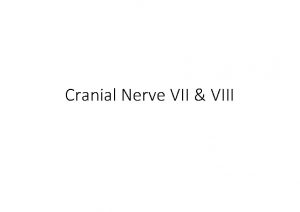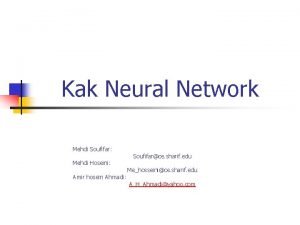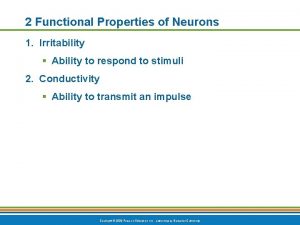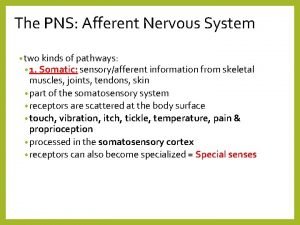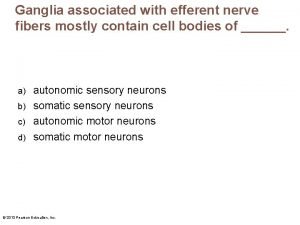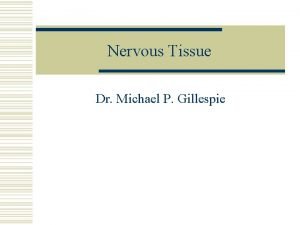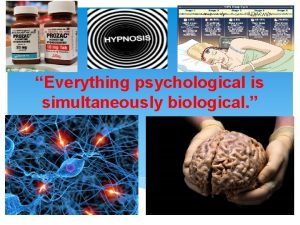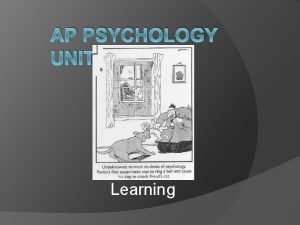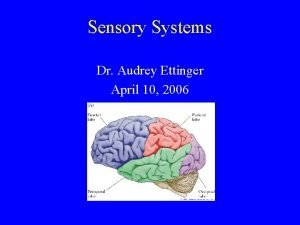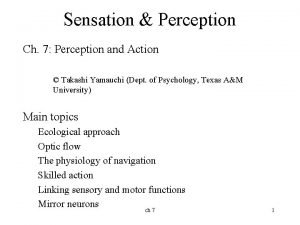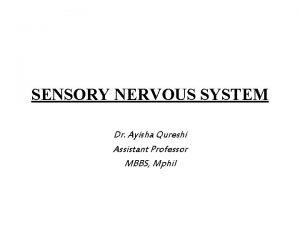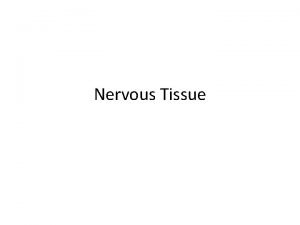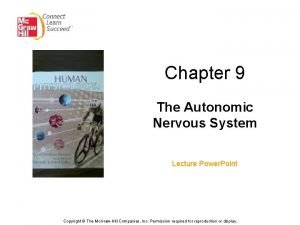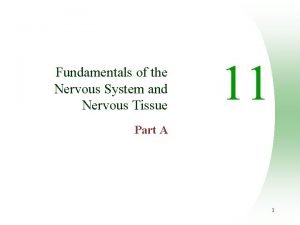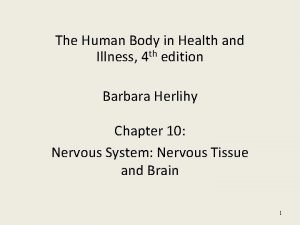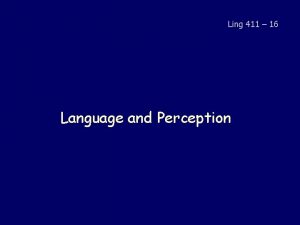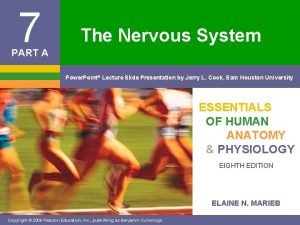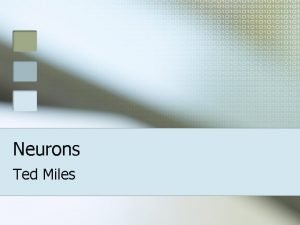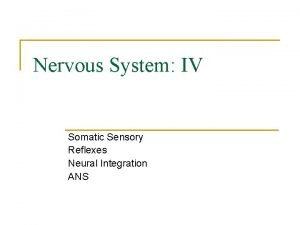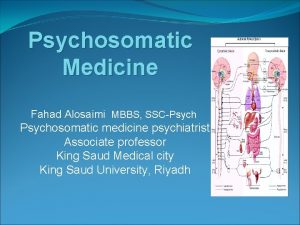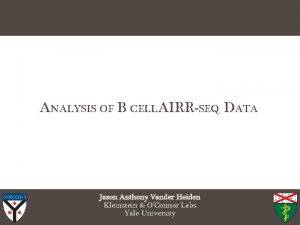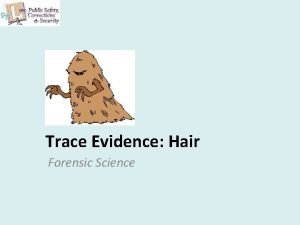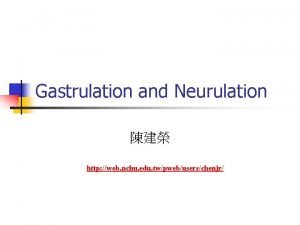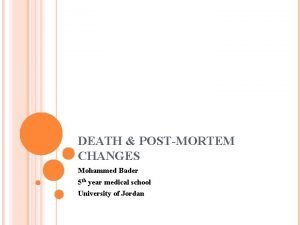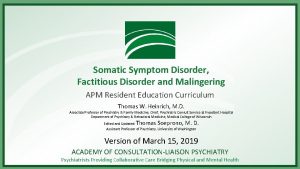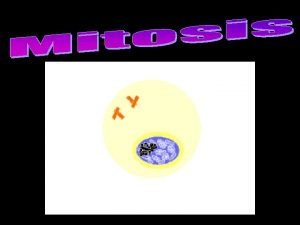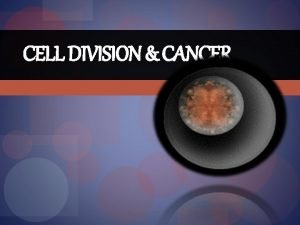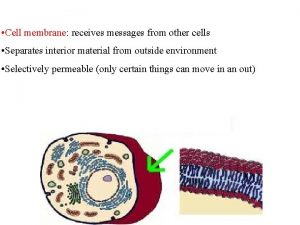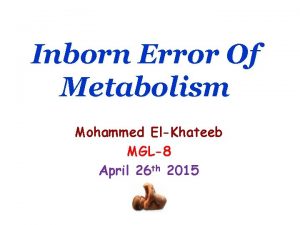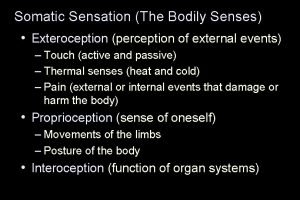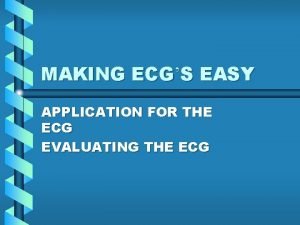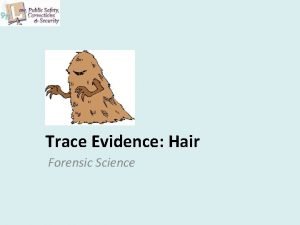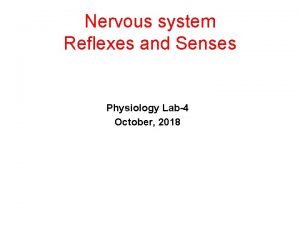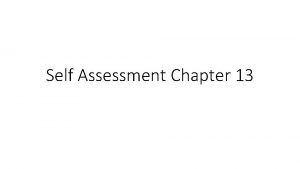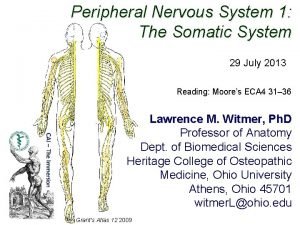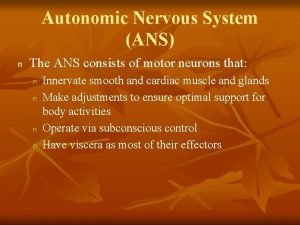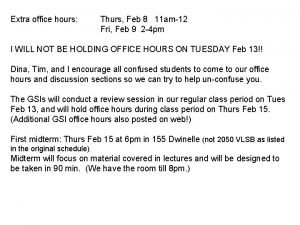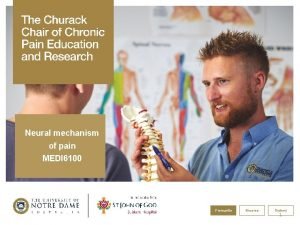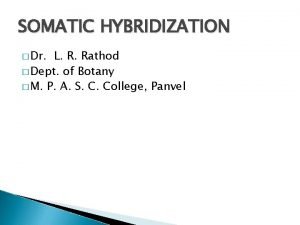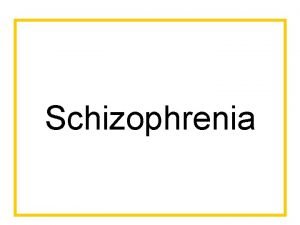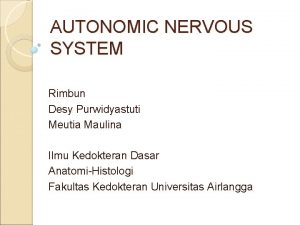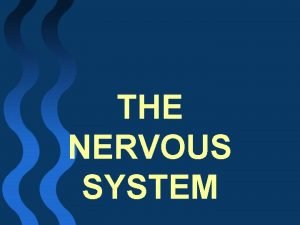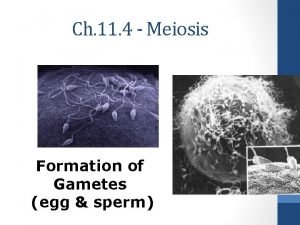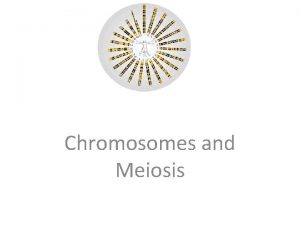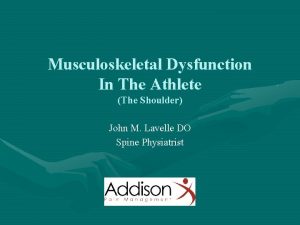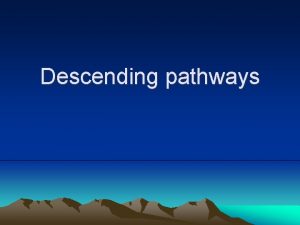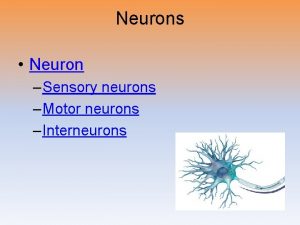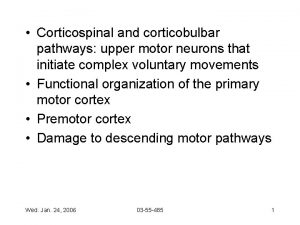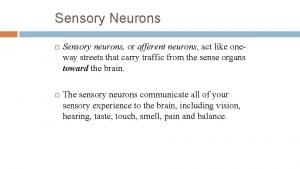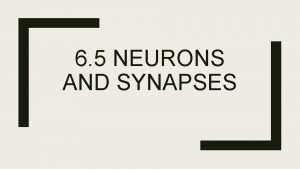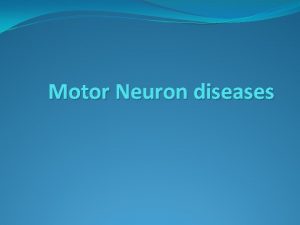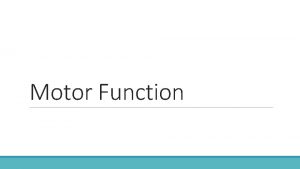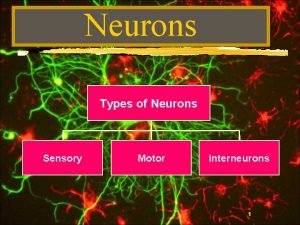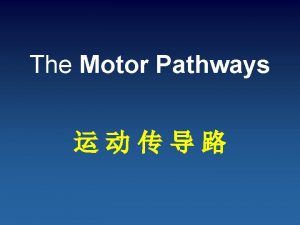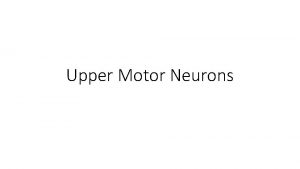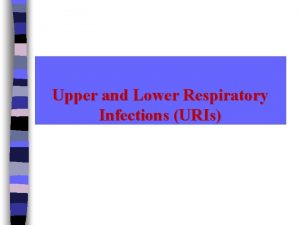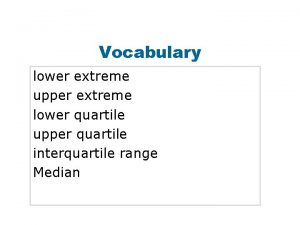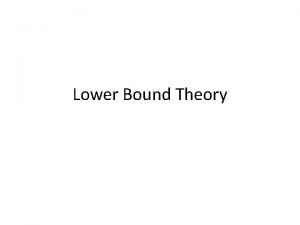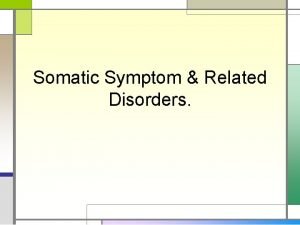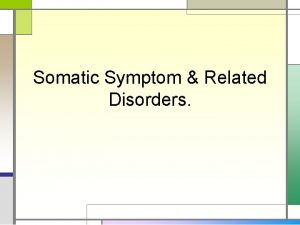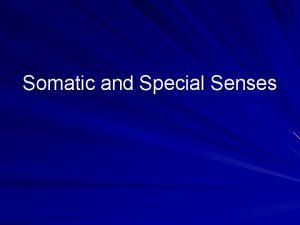Somatic Motor Pathways Upper motor neurons lower motor






































































































































- Slides: 134

Somatic Motor Pathways • Upper motor neurons → lower motor neurons → skeletal muscles. • Neural circuits involving basal ganglia and cerebellum regulate activity of the upper motor neurons.

Organization of the Upper Motor Neuron Pathways • Direct motor pathway- originates in the cerebral cortex. Corticospinal pathway: to the limbs and trunk. Corticobulbar pathway: to the head. • Indirect motor pathway- originates in the brain stem.

Mapping of the Motor Areas • Located in the precentral gyrus of the frontal lobe. • More cortical area is devoted to those muscles involved in skilled, complex or delicate movements.

The Corticospinal Pathways

The Corticobulbar Pathway

Indirect Pathways • Originate in the brain stem. • Include: – – Rubrospinal tract Tectospinal tract Vestibulospinal tract Reticulospinal tract

Modulation of Movement from the Cerebellum • The cerebellum coordinates and smoothes contractions of skeletal muscles during skilled movements and helps maintain posture and balance.

The Spinal Cord is More Than Just a Conduit for Nerve Fibers • Neuronal circuits for walking and various reflexes are contained within the spinal cord. • Higher brain centers activate and command these circuits. – walking – maintaining equilibrium

Motor Organization of the Spinal Cord • Sensory fibers enter the cord and are transmitted to higher centers, or they synapse locally to elicit motor reflexes. • Motor neurons are located in the anterior portion of the cord. – motor neurons are 50 - 100 % bigger than other neurons

Anterior Motor Neurons • Alpha motor neurons – give rise to large type A alpha fibers (~14 microns). – stimulation can excite 3 - 100 extrafusal muscle fibers collectively called a motor unit • Gamma motor neurons – give rise to smaller type A gamma fibers (~5 microns) – stimulation excites intrafusal fibers, a special type of sensory receptor

Interneurons and Propriospinal Fibers • Interneurons – 30 times as many as anterior motor neurons – small and very excitable – comprise the neural circuitry for the motor reflexes • Propriospinal fibers – travel up and down the cord for 1 - 2 segments – provide pathways for multisegmental reflexes

Sensory Receptors of the Muscle • Muscle Spindle – sense muscle length and change in length • Golgi Tendon Organ – sense tendon tension and change in tension

The Muscle Spindle Figure 54 -2; Guyton and Hall

Static Response of the Muscle Spindle • When the center of spindle is stretched slowly - the number of impulses generated by the primary and secondary endings increases in proportion to the degree of stretch. • This is the ‘static response’. • Function of the static nuclear bag and nuclear chain fibers.

Dynamic Response of the Muscle Spindle • When the center of the spindle is stretched rapidly - the number of impulses generated by the primary endings increases in proportion to the rate of change of the length. • This is the ‘dynamic response’. • Function of the dynamic nuclear bag fiber.

Physiologic Function of the Muscle Spindle • Comparator of length between the intrafusal and extrafusal muscle fiber. • Opposes a change in length of the muscle. • When the muscle is stretched the spindle returns it to its original length. • Leads to the stretch reflex.


Control of the Gamma Motor System (Fusimotor System) • Gamma signal excited by the bulboreticular facilatory area of the brain stem. • Secondarily by areas that send impulses to this area. – cerebellum, basal ganglia, cortex • Little is known about the precise control of this system.

Clinical Application of the Stretch Reflex • Knee jerk reflex – striking the patellar tendon with a hammer stretches the quadriceps muscle. – this initiates a stretch reflex which shortens the muscle and causes the knee to move forward. • Can be done with almost any muscle. • Index of the facilitation of the gamma efferents. • Cortical lesions usually increase muscle stretch reflexes.

Golgi Tendon Reflex • Mediated by the golgi tendon organ receptor located in the tendon. • This receptor responds to tension. • When the tension becomes too great the reflex inhibits the motor fibers attached to the tendon. • Function is to equalize force among muscle fibers.

Transmission of Stretch Information to Higher Centers • Muscle spindle and golgi tendon signals are transmitted to higher centers. • This informs the brain of the tension and stretch of the muscle. • Information is transmitted at 120 m/sec. • Important for feedback control of motor activity.

The Withdrawal Reflexes • A painful stimulus causes the limb to automatically withdraw from the stimulus. • Neural pathways for reflex: – nociceptor activation transmitted to the spinal cord – synapses with pool of interneurons that diverge the to the muscles for withdrawal, inhibit antagonist muscles, and activate reverberating circuits to prolong muscle contraction – duration of the afterdischarge depends on strength of the stimulus

Crossed Extensor Reflex • Painful stimulus elicits a flexor reflex in affected limb and an extensor reflex in the opposite limb. • Extensor reflex begins 0. 2 - 0. 5 seconds after the painful stimulus. • Serves to push body away from the stimulus, also to shift weight to the opposite limb.

Other Reflexes for Posture and Locomotion • Pressure on the bottom of the feet cause extensor reflex. – more complex than flexor-crossed extensor reflex • Basic walking reflexes reside in the spinal cord.

Reflexes that Cause Muscle Spasm • Pain signals can cause reflex activation and spasm of local muscles. • Inflammation of peritoneum can cause abdominal muscle spasm. • Muscle cramps caused by painful stimulus in muscle: – can be due to cold, ischemia, of overactivity – reflex contraction increases painful stimulus and causes more muscle contraction

Motor Cortex • Divided into 3 sub areas – primary motor cortex • unequal topographic representation • fine motor movement elicited by stimulation – premotor area • topographical organization similar to primary motor cortex • stimulation results in movement of muscle groups to perform a specific task • works in concert with other motor areas

Motor Cortex (Cont. ) – supplemental motor area • topographically organized • simulation often elicits bilateral movements. • functions in concert with premotor area to provide attitudinal, fixation or positional movement for the body • it provides the background for fine motor control of the arms and hands by premotor and primary motor cortex

Motor Areas of the Cerebral Cortex Figure 55 -3; Guyton and Hall

Figure 55 -2; Guyton and Hall

Specialized Areas of the Motor Cortex • Broca’s area – damage causes decreased speech capability – closely associated area controls appropriate respiratory function for speech • eye fixation and head rotation area – for coordinated head and eye movements • hand skills area – damage causes motor apraxia the inability to perform fine hand movements

Transmission of Cortical Motor Signals • Direct pathway – corticospinal tract – for discrete detailed movement • Indirect pathway – signals to basal ganglia, cerebellum, and brainstem nuclei

Corticospinal Fibers • 34, 000 Betz cell fibers, make up only about 3% of the total number of fibers • 97% of the 1 million fibers are small diameter fibers – conduct background tonic signals – feedback signals from the cortex to control intensity of the various sensory signals to the brain

Other Pathways from the Motor Cortex • Betz collaterals back to cortex sharpen the boundaries of the excitatory signal • Fibers to caudate nucleus and putamen • Fibers to the red nucleus, which then sends axons to the cord in the rubrospinal tract • Reticular substance, vestibular nuclei and pons then to the cerebellum • Therefore the basal ganglia, brain stem and cerebellum receive a large number of signals from the cortex.

Incoming Sensory Pathways to Motor Cortex • Subcortical fibers from adjacent areas of the cortex especially from somatic sensory areas of parietal cortex and visual and auditory cortex. • Subcortical fibers from opposite hemisphere which pass through corpus callosum. • Somatic sensory fibers from ventrobasal complex of the thalamus (i. e. , cutaneous and proprioceptive fibers).

Incoming Sensory Pathways to Motor Cortex (Cont. ) • Ventrolateral and ventroanterior nuclei of thalamus for coordination of function between motor cortex, basal ganglia, and cerebellum. • Fibers from the intralaminar nuclei of thalamus (control level of excitability of the motor cortex), some of these may be pain fibers.

Red Nucleus and the Rubrospinal Tract • Substantial input from primary motor cortex • Primary motor cortex fibers synapse in the lower portion of the nucleus called the magnocellular portion which contains large neurons similar to Betz cells. • Magnocellular portion gives rise to rubrospinal tract. • Magnocellular portion has somatotopic organization similar to primary motor cortex.

Red Nucleus and the Rubrospinal Tract • Stimulation of red nucleus causes relatively fine motor movement, but not as discrete as primary motor cortex. • Accessory route for transmission of discrete signals from the motor cortex.

Red Nucleus and the Rubrospinal Tract Figure 55 -5; Guyton and Hall

Sensory Feedback is Important for Motor Control • Feedback from muscle spindle, tactile receptors, and proprioceptors fine tunes muscle movement. • Length mismatch in spindle causes auto correction. • Compression of skin provides sensory feedback to motor cortex on degree of effectiveness of intended action.

Excitation of Spinal Motor Neurons • Motor neurons in cortex reside in layer V. • Excitation of 50 -100 giant pyramidal cells is needed to cause muscle contraction. • Most corticospinal fibers synapse with interneurons. • Some corticospinal and rubrospinal neurons synapse directly with alpha motor neurons in the spinal cord especially in the cervical enlargement. • These motor neurons innervate muscles of the fingers and hand.

Lesions of the Motor Cortex • Primary motor cortex - loss of voluntary control of discrete movement of the distal segments of the limbs. • Basal ganglia - muscle spasticity from loss of inhibitory input from accessory areas of the cortex that inhibit excitatory brainstem motor nuclei.

Control of Motor Function by the Brainstem • Brainstem as an extension of the spinal cord. – performs motor and sensory functions for the face and head (i. e. , cranial nerves). – similar to spinal cord for functions from the head down. • Contains centers for stereotypic movement and equilibrium.

Support of the Body Against Gravity • The muscles of the spinal column and the extensor muscles of the legs support the body against gravity. • These muscles are under the influence of brainstem nuclei. • The pontine reticular nuclei excite the antigravity muscles. • The medullary reticular nuclei inhibit the antigravity muscles.

Orientation of the Pontine and Medullary Reticular Nuclei Figure 55 -7; Guyton and Hall

Pontine Reticular Nuclei • Transmit excitatory signals through pontine reticulospinal tract. • Pontine reticular nuclei have a high degree of natural excitability. • When unopposed they cause powerful excitation of the antigravity muscles.

Medullary Reticular Nuclei • Transmit inhibitory signals to the antigravity muscles through the medullary reticulospinal tract. • These nuclei receive collateral input from the corticospinal tract, rubrospinal tract, and other motor pathways. • These systems can activate the inhibitory action of the medullary reticular nuclei and counterbalance the signals from the pons.

The Cerebellum (little brain) • responsible for coordinating muscle activity • sequences the motor activities • monitors and makes corrective adjustments in the activities initiated by other parts of the brain • compares the actual motor movements with the intended movements and makes corrective changes

Functional Organization of the Cerebellum • Functionally arranged along the longitudinal axis • Vermis, located at the center, controls axial movements of the neck, shoulders, and hips • Intermediate zone controls motion of distal portions of upper and lower limbs especially the hands and feet • Lateral zone controls sequencing movements of the muscle. Important for timing and coordination of movement.

Axial movements of neck, shoulders and hips Motion of distal limbs, especially hands and feet Sequencing of movements, timing and coordination Figure 56 -2; Guyton & Hall

Afferent Pathways to the Cerebellum • From the brain – corticopontocerebellar pathway from motor and premotor area, somatosensory cortex as well as some pontine nuclei which join this tract. Projects mostly to the lateral areas. – olivocerebellar tract, vestibulocerebellar tract, reticulocerebellar tract • These pathways transmit information about intended motion.

Afferent Pathways to the Cerebellum • from the periphery – dorsal spinocerebellar tract - transmits information mostly from muscles spindle but also from Golgi tendon organs, tactile, and joint receptors • apprises the brain of the momentary status of muscle contraction, muscle tension and limb position and forces acting on the body surface – ventral spinocerebellar tract - signals from anterior horn, and interneurons • transmits information on which signals have arrived at the cord

Efferent Pathways from the Cerebellum • fastigioreticular tract – equilibrium control • cerebellothalamocortical tract – coordinates agonist and antagonist muscle contractions

Neuronal Organization of the Cerebellar Cortex • organized in three layers – molecular cell layer – Purkinje cell layer – granular cell layer • output from the cerebellum comes from a deep nuclear cell layer located below these layers of cortex

Organization of the Cerebellum Figure 56 -7; Guyton & Hall

Neuronal Circuit of the Cerebellum Deep nuclear cells receive excitatory and inhibitory inputs Inhibitory from Purkinje cells Excitatory afferent inputs from climbing fibers and mossy fibers Figure 56 -7; Guyton & Hall Copyright © 2006 by Elsevier, Inc.

Neuronal Circuit of the Cerebellum climbing fibers send branches to the deep nuclear cells before they make extensive connections with the dendrites of the Purkinje cell. Causes complex spike output from Purkinje cell. Figure 56 -7; Guyton & Hall Copyright © 2006 by Elsevier, Inc. all climbing fibers originate from the inferior olive

Neuronal Circuit of the Cerebellum mossy fibers relay all other afferent input into the cerebellum, also send branches to the deep nuclear cell mossy fiber stimulation causes a simple spike output Copyright © 2006 by Elsevier, Inc. Figure 56 -7; Guyton & Hall mossy fibers terminate in the granular cell layer.

Neuronal Circuit of the Cerebellum granular cells send axons to the molecular cell layer where they divide and go a few mm in opposite directions to become parallel fibers in the molecular layer 500 - 1000 granule cells for every Purkinje cell, anywhere from 80, 000 to 200, 000 parallel fibers synapse with each Purkinje cell Figure 56 -7; Guyton & Hall

Deep Nuclear cell activity Inhibited by Purkinje cell input Stimulated by both climbing and mossy fiber input Normally the balance is in favor of excitation Deep nuclear cell at first receives an excitatory input from both the climbing fibers and mossy fibers. This is followed by an inhibitory signal from the Purkinje cells

Deep Nuclear Cell Activity • At beginning of motion there are excitatory signals sent into motor pathways by deep nuclear cells to enhance movement, followed by inhibitory signals milliseconds later. – Provides a damping function to stop movement from overshooting its mark – Resembles a delay-line type of electronic circuit for negative feedback

The Turn-On / Turn-Off Function • cerebellum contributes to the rapid turn-on signals for agonist muscles and turn-off of antagonist muscles at beginning of a motion • then it times the opposite sequence at the end of the intended motion • direct motor pathway via corticospinal tract is enhanced by cerebellum by additional signals to the tract or by signals back to the cortex

The Turn-On / Turn-Off Function • mossy fiber input also to Purkinje cells which activates them after a few millisec. , this results in an inhibitory signal to the deep nuclear cell • this inhibits the agonist muscle which stops its activity

Purkinje Cells Function to Correct Motor Errors • precise motor movement must be learned • climbing fiber input adjusts the sensitivity of the Purkinje cells to stimulation by parallel fibers • this changes the long-term sensitivity of the Purkinje cell to mossy fiber input (i. e. , from muscle spindle, golgi tendon, proprioceptor) • this adjusts the feedback control of muscle movement

Correction of Motor Errors • inferior olivary complex receives input from: – corticospinal tract and motor centers of the brain stem – sensory information from muscles and surrounding tissue detailing the movement that actually occurs • inferior olivary complex compares intent with actual function, if a mismatch occurs output to cerebellum through climbing fibers is altered to correct mismatch

Motion Control by the Cerebellum • most motion is pendular, therefore, there is inertia and momentum • to move a limb accurately it must be accelerated and decelerated in the right sequence • cerebellum calculates momentum and inertia and initiates acceleration and braking activity

Predictive and Timing Function of the Cerebellum • motion is a series of discrete sequential movement • the planning and timing of sequential movements is the function of the lateral cerebellar hemisphere • this area communicates with premotor and sensory cortex and corresponding area of the basal ganglia where the plan originates • the lateral hemisphere receives the plan and times the sequential events to carry out the planned movement

Clinical Abnormalities of the Cerebellum • ataxia and intention tremor – failure to predict motor movement, patients will overshoot intended target • dysdiadochokinesia – failure of orderly progression of movement • dysarthria – failure of orderly progression in vocalization • cerebellar nystagmus – intention tremor of the eyes

Basal Ganglia • Consist of Four Nuclei • striatum – caudate and putamen • globus pallidus • substantia nigra • subthalamus

The basal ganglia are the principle subcortical components of a family of parallel circuits linking the thalamus with the cerebral cortex Figure 56 -11 Figure 56 -12; Guyton & Hall Copyright © 2006 by Elsevier, Inc.

Motor Function of the Basal Ganglia • control of complex patterns of motor activity – writing – using scissors – throwing balls – shoveling dirt – some aspects of vocalization

Function of the Basal Ganglia? • not much is known about the specific functions of each of these structures • thought to function in timing and scaling of motion and in the initiation of motion • most information comes from the result of damage to these structures and the resulting clinical abnormality

Caudate Circuit Caudate extends into all lobes of the cortex and receives a large input from association areas of the cortex Mostly projects to globus pallidus, no fibers to subthalamus or substantia nigra Most motor actions occur as a result of a sequence of thoughts. Caudate circuit may play a role in the cognitive control of motor functions Figure 56 -12; Guyton & Hall Copyright © 2006 by Elsevier, Inc.

Putamen Circuit Mostly from premotor and supplemental motor cortex to putamen then back to motor cortex. Figure 56 -11; Guyton & Hall

Neurotransmitters in the Basal Gangelia Figure 56 -14; Guyton & Hall

Lesions of Basal Ganglia • globus pallidus – athetosis - spontaneous writing movements of the hand, arm, neck, and face • putamen – chorea - flicking movements of the hands, face, and shoulders • substantia nigra – Parkinson's disease - rigidity, tremor and akinesia – loss of dopaminergic input from substantia nigra to the caudate and putamen

Lesions of Basal Ganglia • subthalamus – hemiballismus - sudden flailing movements of the entire limb • caudate nucleus and putamen – huntington’s chorea - loss of GABA containing neurons to globus pallidus and substantia nigra

Integration of Motor Control • spinal cord level – preprogramming of patterns of movement of all muscles (i. e. , withdrawal reflex, walking movements, etc. ). • brainstem level – maintains equilibrium by adjusting axial tone • cortical level – issues commands to set into motion the patterns available in the spinal cord – controls the intensity and modifies the timing

Integration of Motor Control (cont’d) • cerebellum – function with all levels of control to adjust cord motor activity, equilibrium, and planning of motor activity • basal ganglia – functions to assist cortex in executing subconscious but learned patterns of movement, and to plan sequential patterns to accomplish a purposeful task

Overall scheme for integration of motor function Figure 56 -10; Guyton & Hall


Physiologic Anatomy of Cerebral Cortex • Each area of the cortex is connected to a specific part of the thalamus. • When thalamic connection is lost cortical function stops. • All sensory pathways pass through the thalamus with the exception of the olfactory tract.

Physiologic Anatomy of Cerebral Cortex Figure 57 -5; Guyton & Hall

Dominant and Non-Dominant Hemisphere • Wernicke’s area more developed in one hemisphere, responsible for verbal symbolism and related intelligence. • 95% of population has a left dominant hemisphere. • Wernicke’s area can be as much as 50% larger in the dominant hemisphere.

Dominant and Non-Dominant Hemisphere (Cont’d) • Damage to dominant Wernicke’s area leads to dementia. • Non-dominant side related to other forms of sensory intelligence (music, sensory feelings).

Intellectual Functions of the Prefrontal Association Area • responsible for calling forth stored information and using it to obtain a goal • responsible for concerted thinking in a logical sequence – damage causes an inability to keep tract of simultaneous bits of information, easily distracted

Intellectual Functions of the Prefrontal Association Area (Cont’d) • elaboration of thought – prognosticate, plan, consider consequences of motor actions before they are performed – correlate widely divergent information, control one’s activities

Sensory Aspects Communication Wernicke's aphasia Destruction of the visual and auditory association areas results in an inability to understand the written or spoken word. Figure 57 -7; Guyton & Hall

Motor Aspects of Communication • Speech involves two things – formation in the mind of thoughts to be expressed and the choice of words – motor control of vocalization and the act of vocalization • Formation of word, thought and choice of words is function of Wernicke’s area. • Broca’s area controls the motor coordination required for speech.

Function of the Corpus Callosum • connects the two hemispheres and allows transfer of information • interruption of these fibers can lead to bizarre types of anomalies – dominant hemisphere understands spoken word – non dominant hemisphere understands written word and can elicit motor response without dominant side knowing why response was performed

Thoughts and Memory • Neural mechanism for thought is not known. • Most likely a specific pattern of simultaneous neural activity in many brain areas. • Destruction of cerebral cortex does not prevent one from thinking. – However, depth of thought and level of awareness may be less.

Learning and Memory • Learning is the ability to acquire new information or skills through instruction or experience. • Memory is the process by which information acquired through learning is stored and retrieved.

Memory • Change in the capability of synaptic transmission from neuron to neuron as a result of prior stimulation. • Memory trace is a specific pattern or pathway of signal transmission. • Once established they can be activated by the thinking mind to reproduce the pattern and thus the memory.

3 Types of Memory • immediate memory – lasts for seconds or minutes • short-term memory – lasts for days to weeks • long-term memory – lasts for years or for a lifetime

Mechanism of Memory • Immediate memory may result from synaptic potentiation through the accumulation of calcium in the presynaptic membrane. – would promote neurotransmitter release • Short-term memory may result from a temporary physical or chemical change in the pre- or postsynaptic membrane.

Cellular Basis for Memory • repetitive stimulation causes a progressive decline in sensitivity called habituation • results from progressive decline in the number of active calcium channels • less calcium entry less transmitter released • stimulation of facilitator terminal prevents habituation

Molecular Basis for Memory Transmitter activates G protein which in turn activates adenylate cyclase resulting in an increase in c. AMP activates a protein kinase that phosphorylates a component of the K+ channel blocking its activity. This prolongs the action potential which increases transmitter release. Figure 57 -9; Guyton & Hall

Long-Term Memory • results from a structural change in the synapse • increase in the area for vesicular release therefore, more transmitter is released • during periods of inactivity the area decreases in size • enlargement of the release site area results from synthesis of release site proteins

Consolidation of Memory • converting immediate into short and long-term memory • results from chemical, physical and anatomical changes in the synapse • requires time • interruption of the process by electrical shock or by anesthesia will prevent memory development • rehearsal enhances consolidation

Brain Centers and Memory • Thalamic structures are important for recalling memories. • Damage to thalamus causes retrograde amnesia or the inability to recall stored experiences. • Thalamus scans the cortex for the area and the circuit for the stored memory.

Schematic of the Limbic System Components Figure 58 -5; Guyton & Hall

Location of the Limbic System Figure 58 -4; Guyton & Hall

Hypothalamus • major output pathway of the limbic system • vegetative functions: – neurogenic control of arterial pressure – regulation of body temperature – regulation of fluid volume – regulation of endocrine gland secretion • growth hormone, thyroid hormone, glucocorticoid secretion, sex hormones

Behavioral Functions of the Hypothalamus and Related Areas • lateral hypothalamus – eating, thirst, general level of activity, rage • ventromedial nucleus – satiety, tranquillity • periventricular nucleus – fear, punishment reactions • anterior and posterior hypothalamus – sexual drive

Functional Areas of the Hypothalamus Figure 58 -6; Guyton & Hall

Behavior and its Control • Almost all behaviors are associated with either reward or punishment. • Several limbic structures are concerned with the affective nature of the sensory experience–is it pleasant or unpleasant? – Reward center - located around medial forebrain bundle (the lateral and ventromedial hypothalamus). – Punishment center - located in central gray around the aqueduct and extending into periventricular zones of hypothalamus and thalamus. Punishment always takes precedent over reward

Function of Other Limbic Areas • amygdala – receives input from other areas of limbic system as well as most areas of the cortex – sends output back to cortex as well as into hippocampus, septum, and hypothalamus – functions in behavioral awareness at the semiconscious level – projects into limbic system one’s status with respect to the surroundings and current thoughts – helps pattern behavior appropriate for the each occasion

Function of Other Limbic Areas • hippocampus – originated as part of the olfactory cortex – in lower animals the sense of smell is an important determinant of behavior (is it good to eat, does it smell like danger, is it sexually inviting) – therefore, the early hippocampus was involved in decision making by determining the importance of the incoming information

Hippocampus – memory and learning – damage causes anterograde amnesia – reward and punishment determine whether or not information will be stored as memory – a person becomes habituated to indifferent stimuli but learns any sensory experience that causes pain or pleasure – hippocampus provides the drive to rehearse and consolidate these sensory experiences

Limbic Cortex • cerebral association area for control of behavior • stimulation of various portions of this area can elicit almost all behaviors in an animal’s repertoire

The role of Reticular Activating System (RAS) in Awakening • Consists of neurons whose axons project from the reticular formation through the thalamus to the cerebral cortex. • Increased activity of the RAS causes awakening from sleep (arousal).

Activating Systems of the Brain • Cerebrum requires a constant input to remain active. • Signals from the brainstem activate wide areas of the cortex (background activation) or specific areas to perform discrete tasks.

Excitatory Signals from the Brainstem • Bulboreticular facilitory area - sends excitatory signals to the antigravity muscles - sends excitatory signals to the thalamus and from here they are distributed to widespread areas of the cortex • Bulboreticular area is excited by signals from the periphery, especially pain signals and also signals from the cortex (positive feedback).

Inhibitory Signals from the Brainstem • reticular inhibitory area – sends inhibitory signals to the bulboreticular area – when the inhibitory area is excited, it will decrease the activity of the excitatory area and decrease the activity of the cortex

Location of excitatory and inhibitory areas of the brain Figure 58 -1; Guyton & Hall

Neurohumoral Control of Brain Activity Figure 58 -3; Guyton & Hall

Sleep • unconsciousness from which one can be aroused by sensory stimulus • different from coma from which one cannot be aroused • two types of sleep: – slow wave or deep sleep – REM sleep or paradoxical sleep

Fig. 15. 11

Slow Wave Sleep • restful sleep at the beginning of the sleep period • associated with a decrease in vegetative functions • usually not associated with dreaming; dreams do occur but they are not remembered

Rapid Eye Movement (REM) Sleep • associated with active dreaming • peripheral muscle tone is inhibited • associated with an increase in cortical activity and metabolism • brain waves similar to wakefulness • begin about 90 minutes after falling asleep and reappear at 90 minute intervals – last for progressively longer periods of time each time they occur, a few minutes at first, 30 minutes toward the end of the sleep period

Why Do We Sleep? • mechanism is unknown • probably an active inhibitory process in which the excitatory reticular neurons are inhibited • stimulation of the raphe nuclei causes sleep – these nuclei release serotonin which is thought to induce sleep – blockade of serotonin formation causes prolonged wakefulness in animals, however, blood levels of serotonin are lower during sleep

Why Do We Sleep? • stimulation of other brain regions can also induce sleep • nucleus of the solitary tract – solitary tract stimulation will not produce sleep if the raphe nuclei are destroyed – therefore, solitary tract may be stimulating release of serotonin from the raphe nuclei • suprachiasmatic area of the rostral hypothalamus, diffuse thalamic nuclei

Why Do We Sleep? • accumulation of sleep factors – muramyl peptide - found in CSF and urine of animals keep awake for prolonged periods, will cause sleep when injected into third ventricle – also a peptide isolated from the blood of sleeping animals – also substance from brain stem of animals keep awake • lesions of the raphe nuclei can prevent sleep

REM Sleep • function of REM sleep is unknown – lesions of the locus ceruleus prevent REM sleep – may be important for neural development – testing the cortex to see if it can be brought to activity

Sleep Cycle • no explanation for the sleep - wakefulness cycle • however, there are many theories – sleep cycle may be caused by fatigue of excitatory areas to induce sleep and fatigue of inhibitory areas of the lower brain to awaken. – sleep probably is an active process driven by a center below the midpontine level of the brain stem.

Fig. 15. 11

Physiological Effect of Sleep • little on the body itself – decrease in sympathetic tone, muscle tone, fall in arterial pressure • profound effect on the brain – lack of sleep can lead to altered mental states • paranoia, psychoses • sleep probably functions to balance the activity of the various areas of the brain, to reset/rezero/reboot neuronal circuits

Brain Waves • electrical recordings from the surface of the brain • characterized as alpha, beta, theta and delta depending on the frequency • each functional state of the brain has a characteristic pattern of brain waves (sleep, wakefulness, epilepsy, psychoses, etc. )

Alpha and Beta Waves • Alpha waves – occur at 8 -13 Hz – mostly from occipital cortex but can also be found in frontal and parietal regions as well – occur during quiet resting states of cerebration, they disappear when there is a specific mental activity (opening of the eyes, intense mental concentration or stress) or during sleep – will not occur without cortical connection to thalamus • Beta waves – occur at 14 - 80 Hz – occur during intense mental activity or stress

Theta and Delta Waves • Theta waves – occur at 4 - 7 Hz – recorded from parietal and temporal regions in children – occur during emotional stress in adults particularly in response to disappointment or frustration • Delta waves – all waves below 3. 5 Hz – occur during deep sleep thought to be activity of the cortex independent of signals from lower brain areas

Brain Waves Figure 59 -1; Guyton & Hall

Epilepsy • uncontrolled excessive activity of a part or all of the central nervous system • grand mal – spasmodic contraction of the muscles followed by an alternating contraction and relaxation – this is called a tonic-clonic convulsion which causes violent jerky muscle contractions – excessive activity lasts for 30 seconds to 3 -4 minutes

Epilepsy • grand mal – caused by an overly excitable area of the brain called a focus – causes massive activation of reverberating circuits which reactivate themselves many times • petit mal – short periods of unconsciousness with twitching contractions of the muscles of the face

Epilepsy • petit mal (cont’d) – characteristic electrical pattern called spike and dome • focal epilepsy – localized organic lesion – can be confined to a single area of the brain or it can spread to adjacent regions

EEG Activity During Epilepsy Figure 59 -5; Guyton & Hall
 Somatic motor pathway
Somatic motor pathway Upper motor neurons
Upper motor neurons Efferent motor neurons
Efferent motor neurons Autonomic motor neurons regulate visceral activities by
Autonomic motor neurons regulate visceral activities by Muscle tone
Muscle tone Upper lower class
Upper lower class Upper and lower control limit formula
Upper and lower control limit formula Symmetric matrix multiplication
Symmetric matrix multiplication Upper bound of 405 to 3 significant figures
Upper bound of 405 to 3 significant figures Programme upper lower
Programme upper lower 2 significant figures upper and lower bounds
2 significant figures upper and lower bounds Upper respiratory system
Upper respiratory system Box-and-whisker plots worksheet
Box-and-whisker plots worksheet In the poset (z+ )
In the poset (z+ ) Upper lower bounds
Upper lower bounds How to find the critical f value
How to find the critical f value Roof plan examples
Roof plan examples Rounding upper and lower bounds
Rounding upper and lower bounds Nearest whole number upper and lower bounds
Nearest whole number upper and lower bounds Upper bound and lower bound in array
Upper bound and lower bound in array If lclp is negative number, we set the lclp = 0. why?
If lclp is negative number, we set the lclp = 0. why? Nearest whole number upper and lower bounds
Nearest whole number upper and lower bounds Ye who enter here abandon all hope
Ye who enter here abandon all hope Upper egypt and lower egypt
Upper egypt and lower egypt What divided upper and lower egypt
What divided upper and lower egypt Upper and lower respiratory tract
Upper and lower respiratory tract Upper airway and lower airway
Upper airway and lower airway Upper specification limit and lower specification limit
Upper specification limit and lower specification limit Uti upper and lower
Uti upper and lower Greatest lower bound and least upper bound
Greatest lower bound and least upper bound Mesophyll function
Mesophyll function Somatic vs autonomic nervous system
Somatic vs autonomic nervous system Site of somatic motor neuron cell bodies
Site of somatic motor neuron cell bodies Ciliary ganglion
Ciliary ganglion Somatic motor neuron
Somatic motor neuron Somatic motor function
Somatic motor function Lhermitte’s sign
Lhermitte’s sign Sympathetic nervous system def
Sympathetic nervous system def Spinal nerves
Spinal nerves Motor (efferent) division
Motor (efferent) division Motor pathways
Motor pathways Medullary pyramids
Medullary pyramids Direct motor pathways
Direct motor pathways Direct and indirect motor pathways
Direct and indirect motor pathways Lower motor neuron
Lower motor neuron Paraplrgia
Paraplrgia Lower motor neuron
Lower motor neuron Postasthmatic
Postasthmatic Umnl vs lmnl
Umnl vs lmnl Anal wink reflex
Anal wink reflex Bipolar neurons
Bipolar neurons Functional classification of neurons
Functional classification of neurons Efferent division of nervous system
Efferent division of nervous system Neuron processes
Neuron processes Figure 8-2 neurons and neuroglia
Figure 8-2 neurons and neuroglia 1st order 2nd order 3rd order neurons
1st order 2nd order 3rd order neurons Mirror neurons
Mirror neurons Neurons
Neurons Biopsychology revision
Biopsychology revision Nodes of ranvier
Nodes of ranvier Mirror neurons location
Mirror neurons location Fourth order neurons
Fourth order neurons Chapter 48 neurons synapses and signaling
Chapter 48 neurons synapses and signaling Virtual neurons
Virtual neurons Brodman area 4
Brodman area 4 Pruning neurons
Pruning neurons Myelinzation
Myelinzation Mirror neurons ap psych
Mirror neurons ap psych Types of synapse
Types of synapse What is the minimum number of neurons in a reflex arc
What is the minimum number of neurons in a reflex arc Nervous system of grasshopper
Nervous system of grasshopper Chapter 48 neurons synapses and signaling
Chapter 48 neurons synapses and signaling Vestibulocochlear nerve nuclei
Vestibulocochlear nerve nuclei Input neurons
Input neurons Irritability of neurons
Irritability of neurons Type 1 cutaneous mechanoreceptors
Type 1 cutaneous mechanoreceptors In neurons, efferent is to ______ as afferent is to ______.
In neurons, efferent is to ______ as afferent is to ______. Potencial de acción
Potencial de acción How neurons communicate
How neurons communicate Reinforcement schedule psychology definition
Reinforcement schedule psychology definition Audrey ettinger
Audrey ettinger Input neurons
Input neurons Inverse projection problem psychology
Inverse projection problem psychology Receptive fields of sensory neurons
Receptive fields of sensory neurons Unipolar neurons are found in
Unipolar neurons are found in Preganglionic and postganglionic parasympathetic neurons
Preganglionic and postganglionic parasympathetic neurons Label the different types of neuronal pools in the figure.
Label the different types of neuronal pools in the figure. Homunculus
Homunculus What is language
What is language Unipolar neurons are found in
Unipolar neurons are found in Characteristics of sensory neurons
Characteristics of sensory neurons What are neurons composed of
What are neurons composed of Proprioception autism
Proprioception autism Somatic symptoms
Somatic symptoms Somatic hypermutation
Somatic hypermutation Medulla structure
Medulla structure Somatic and autonomic nervous system
Somatic and autonomic nervous system Primitive node
Primitive node Somatic death
Somatic death Tabes dorsalis
Tabes dorsalis Sam byron
Sam byron What is the spinal cord made of
What is the spinal cord made of Somatization disorder dsm 5
Somatization disorder dsm 5 Cell cycle
Cell cycle Neuro tract
Neuro tract Somatic vocabulary
Somatic vocabulary Germ cell vs somatic cells
Germ cell vs somatic cells Mneunomics
Mneunomics Somatic
Somatic Somatic vs gamete
Somatic vs gamete Somatic
Somatic Somatic tremor artifact
Somatic tremor artifact Interrupted medulla
Interrupted medulla Cortical fusi definition forensics
Cortical fusi definition forensics Somatic symptom disorder
Somatic symptom disorder Somatic death and molecular death
Somatic death and molecular death Somatic reflex
Somatic reflex Dermatome
Dermatome Visceral afferent vs efferent
Visceral afferent vs efferent Embryo rescue technique
Embryo rescue technique Somatic symptom disorder
Somatic symptom disorder Somatic nervous system (sns)
Somatic nervous system (sns) Pomato somatic hybrid
Pomato somatic hybrid Somatic reflex vs visceral reflex
Somatic reflex vs visceral reflex Gamete mutation definition
Gamete mutation definition Affinity maturation somatic hypermutation
Affinity maturation somatic hypermutation Pain ascending pathway
Pain ascending pathway Somatic hybridization diagram
Somatic hybridization diagram Somatic delusions
Somatic delusions Somatic pathway
Somatic pathway Somatic nervous system
Somatic nervous system Random assortment vs independent assortment
Random assortment vs independent assortment Body cells are also called
Body cells are also called Rib somatic dysfunction
Rib somatic dysfunction Somatic sx disorder
Somatic sx disorder

